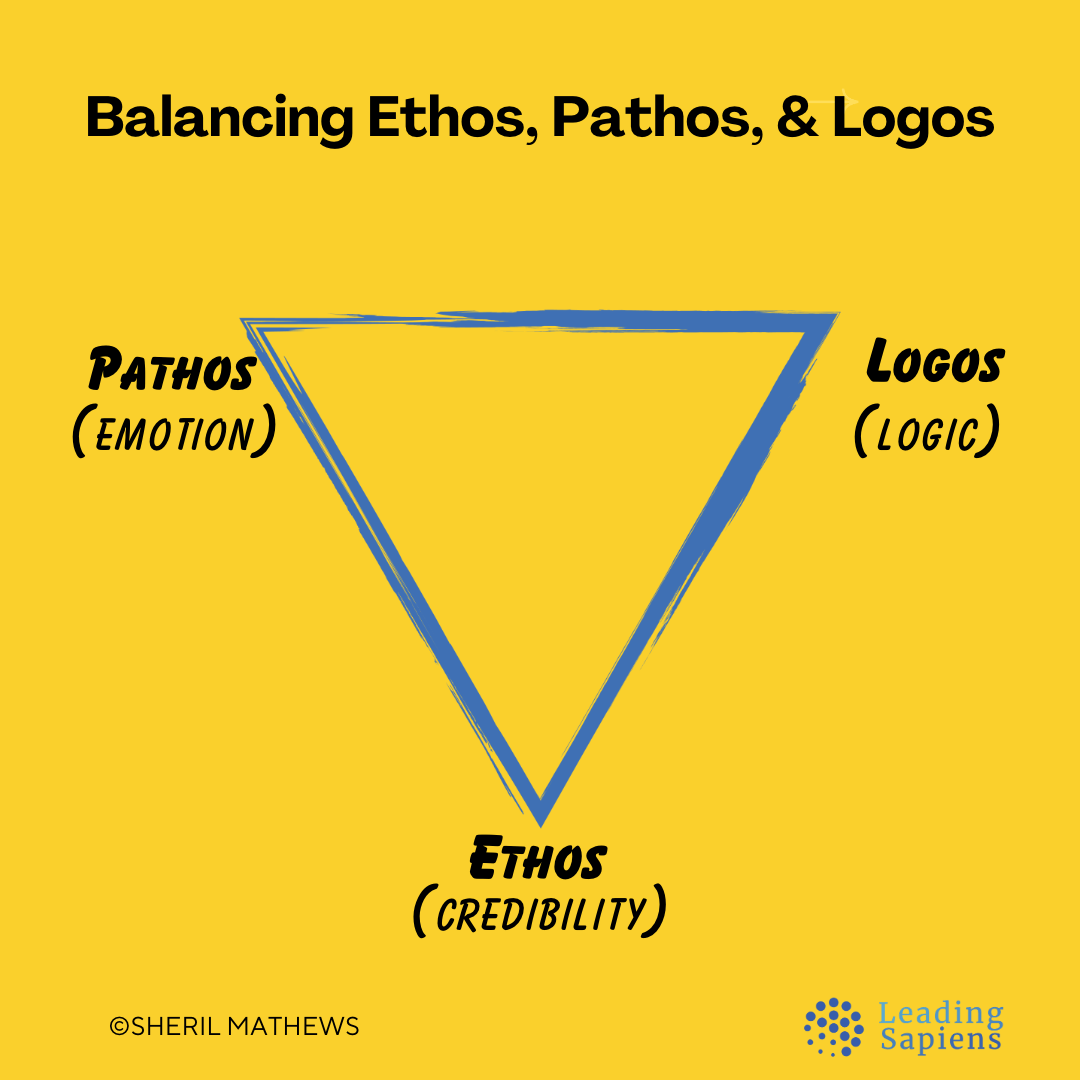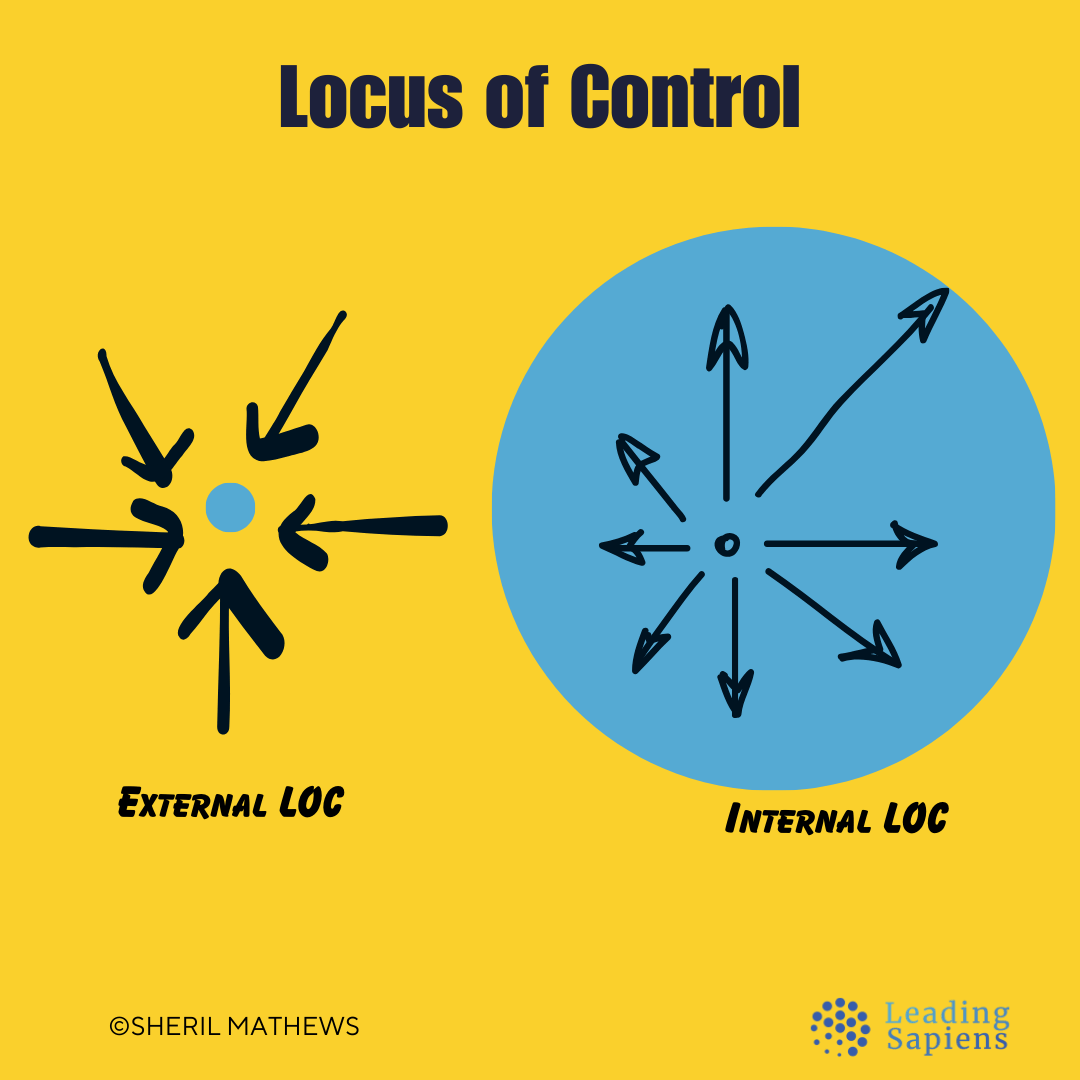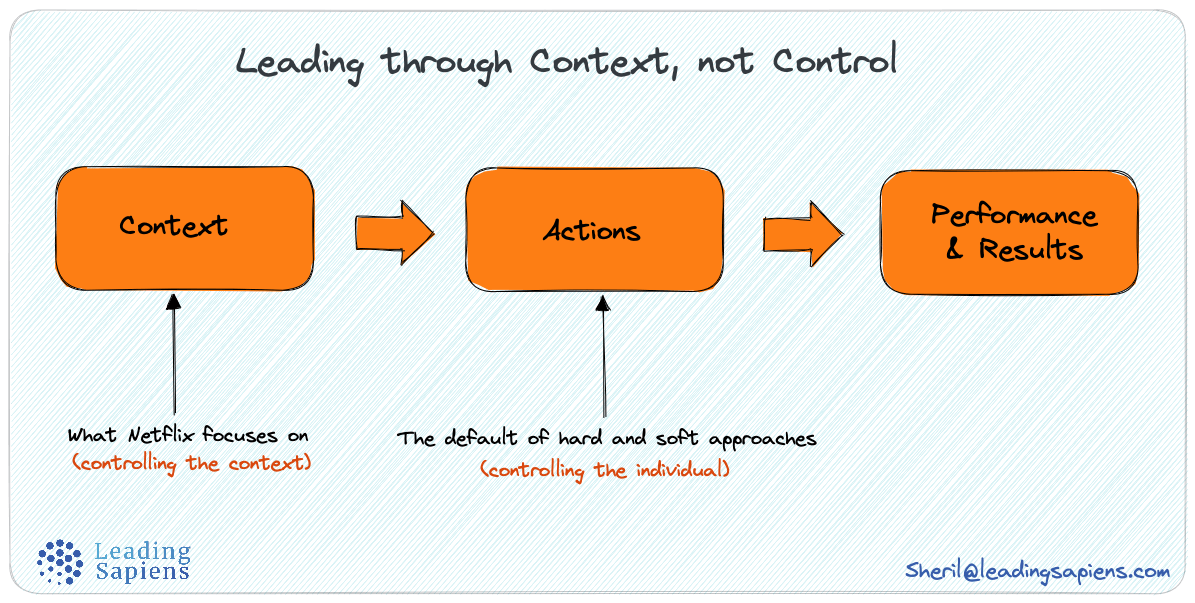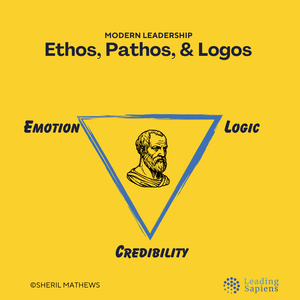The framework of ethos, pathos, and logos was developed in the 4th century BC by Aristotle. It’s a simple but also robust model for effective persuasion and communication that has withstood the test of time. And yet most leaders are either unaware or it, or don’t really know it's importance and sequence. In this piece, I examine what ethos, pathos, and logos are, why they’re critical to effective leadership, and how to develop them.
- Aristotle’s Ethos, Pathos, and Logos
- What is Ethos
- What is Pathos
- What is Logos
- Balancing Ethos, Pathos, and Logos
- Why Ethos, Pathos, and Logos matter in modern leadership
- Related reading
Aristotle’s Ethos, Pathos, and Logos
There are numerous articulations of the framework, but it’s best to start at the source. In his classic Rhetoric, Aristotle mentions three kinds of what he calls “rhetorical influencing” [1,2] and defines the three essential elements of persuasive communication: ethos (credibility), pathos (emotion), and logos (logic):
The first kind of persuasion, the ethos depends on the personal character of the speaker; the second the pathos on putting the audience into a certain frame of mind; the third the logos on the proof, or apparent proof, provided by the words of the speech itself.
He explains:
Persuasion is achieved by the speaker’s personal character when the speech is so spoken as to make us think him credible. We believe good men more fully and more readily than others: this is true generally whatever the question is, and absolutely true where exact certainty is impossible and opinions are divided. ... It is not true, as some writers assume in their treatises on rhetoric, that the personal goodness revealed by the speaker contributes nothing to his power of persuasion; on the contrary, his character may almost be called the most effective means of persuasion he possesses.
Secondly, persuasion may come through the hearers, when the speech stirs their emotions. Our judgments when we are pleased and friendly are not the same as when we are pained and hostile. It is towards producing these effects, as we maintain, that present-day writers on rhetoric direct the whole of their efforts. …
Thirdly, persuasion is effected through the speech itself when we have proved a truth or an apparent truth by means of the persuasive arguments suitable to the case in question.
Aristotle taught this framework to Alexander the Great in the context of charisma, oratory, and communication. However, this is equally applicable to the wider domain of leadership.
How so? Because all three combine to what essentially adds up to trust in you and your leadership. And without the key element of trust, effective leadership is almost impossible.
Let’s examine closely what ethos, pathos, and logos are, how they relate to each other, and how you can build each aspect in your leadership.
What is Ethos
Ethos is the leader’s character, credibility, and authenticity. It’s your ability to convey integrity and goodwill, while also establishing authority and expertise in a domain.
Ethos is communicated through tone, style, communication skills, and body language. How you deliver a message impacts how credible you come across. And this aspect of ethos is what often gets the most attention.
However, ethos is also about aspects that are built over time: your reputation, consistency in words and actions, and the combination of trust and expertise. Ethos can be characterized as authenticity, trustworthiness, character, and credibility. These cannot be manufactured overnight, and people “know when they see it”.
It’s important to note the order in which Aristotle put the three. He gives ethos the top priority and logic the last. This is interesting because many leaders rely too much on logic and so-called “data”, and don’t pay as much attention to pathos or ethos.
In the section on balancing the three, I delve further into how ethos compares with pathos and logos.
How to develop Ethos
While most leaders intuitively understand the importance of ethos, it can also be the most elusive because many of its aspects require time. But done consistently, it’s very much doable.
Here are some pointers to build your ethos (authenticity, credibility, character):
- Establish common ground and understand where your team/audience are coming from. If they don’t think you actually get their challenges, you won’t appear credible and words will fall flat. This is the underlying notion behind the clichéd but always true line, “People do not care how much you know until they know how much you care.”
- Have a track record of knowledge base and integrity in both words and actions. Consistency in actions and messaging helps builds trust over time. When you consistently follow up on promises and maintain a steady course, it creates a reliable and trustworthy image. People are more likely to believe and support leaders who are predictable in their values and behavior.
- Do the work to build competence and experience in your domain. But you also have to “show your work”. Don’t assume your audience already knows. Sharing relevant experiences and highlighting your understanding of complex issues helps to establish authority and credibility.
- Do the hard things, make tough decisions, and do what others won’t do out of fear. It's more existential and I call it "organizational courage". If you don't step out of your comfort zone, why should your team?
- Encourage open exploration of ideas, including letting others challenge your own notions.
- Have a clear recognition of where you are competent and where you need help. You don’t have to rest on your laurels, but also be aware of your strengths and achievements and stay open to keep learning.
- Know how your people actually get work done instead of leading by proxy.
- One way you can increase your ethos is to balance advocacy with inquiry. Many leaders are naturally prone to too much advocacy, and not enough inquiry, which hurts their credibility. Roger Martin calls this assertive inquiry.
Building a reputation for being reliable, ethical, and effective takes time, but is a critical aspect of establishing long-term credibility. You also have to be mindful of how others see you. A useful tool to identify personal blindspots is the Johari Window.
What is Pathos
The heart has its reasons which reason knows not of.
— Blaise Pascal
Pathos is the persuasive element that appeals to people’s emotions. It’s not your passion per se, but instead understanding and engaging that of your audience. Do they feel the same way you do about your topic? Do you know how they actually feel? It's your ability to create a connection that goes beyond pure logic.
Pathos relies on mental images, relationships, and stories to appeal to people’s hearts rather than just their minds. It means understanding, aligning, and empathizing with emotions such as anger, fear, shame, pity, and even envy.
It often provides the impetus for action and is essential for inspiring movement on a large scale.
How to develop Pathos
- Invest the time and effort required to really understand people’s feelings, desires, fears, attitudes, and values. Don’t rely on plain logic or dismiss it as “they need to grow up”, or that “it should be obvious”.
- We human beings understand stories much more than facts and figures. It’s one reason why politicians use and misuse them extensively.
- Understanding the situation from the other’s perspective while sounding straightforward is never easy. One tool to get better at this is the ladder of inference.
- Your own personal stories and experiences go a long way in how well people can relate and connect with you. Shared experiences are even better.
- Understand how to manage context and the use of framing to guide teams in the right direction without having to dictate or control.
What is Logos
Logos relies on logic, reason, and clear articulation of ideas. It involves using logical arguments, data, consequences, and scientific proof to appeal to your audience's intellect.
It means ensuring consistency in arguments, presenting clear claims, and providing supporting evidence. Logos is your rationale for taking action. It focuses on presenting facts and conveying them clearly, providing a rigorous case for your approach.
How to develop Logos
Most modern-day leaders are already pretty good in this area, almost to a point of fault. The problem lies in relying too much on logic and forgetting about the other two. Below are a couple of pointers that are often missed:
- Show your reasoning and how you reached your conclusions, instead of assuming that your audience is already up to speed. The very act of showing your process increases credibility.
- Messages require repetition and variation over time before they sink in. A one-time amazing speech is far less effective than a mediocre message done consistently and variedly.
Balancing Ethos, Pathos, and Logos
Perhaps the most important, but also an often neglected aspect of Aristotle’s framework is what he put first and what was last. He put Ethos at the forefront while logic came last.
With a solid base of credibility, you can tweak your message and approach based on your audience — technical audiences will lean more towards analytical logic (logos) while broader audiences will need more emphasis on storytelling and emotions (pathos).
But leaders have to be careful here — leaning too much on either pathos or logos hurts trustworthiness. Most importantly, the effectiveness of both logos and pathos relies on a solid base of authenticity (ethos) of the leader.
We can visualize this framework as an inverted triangle with pathos and logos at either ends, and ethos forming the apex and base of the triangle.

To be effective, you need to have all three. However, I would argue that no amount of pathos or logos can overcome a lack of ethos aka character and authenticity. Thus, ethos anchors the triangle and why I’ve chosen to depict it that way.
When trust is lacking, the whole edifice becomes wobbly and untenable. It’s no wonder that Aristotle deemed ethos the most important element of persuasion, and by extension of leadership.
Frances Frei and Anne Morriss call this the Trust Triangle of leadership.
Why Ethos, Pathos, and Logos matter in modern leadership
Aristotle’s framework is over 2,000 years old, but perhaps much more relevant to modern-day managers. As noted earlier, most leaders by default are strong in the logic and analytical aspects. What many lack is an equal grounding in the ethos and pathos aspects of their leadership.
Why does an over-emphasis on logic often fall short?
- We are increasingly working in complexity where one person, even entire teams, don’t have all the answers. This means the leader’s ability to work with a wide range of stakeholders is key. It’s difficult to do that without having pathos and credibility. The same goes for drawing out the best from your teams.
- Increasing ambiguity means there’s not always a clear pathway or solution to complex problems. How teams respond to a situation often depends on the leader’s ability to create the context within which teams take actions. Ethos, pathos, and logos is an essential framework to help create that context.
- In increasingly flat and matrixed organizations, positional authority can only go so far. To be effective, you have to work across a wide range of positions regardless of authority, and frequently with a complete lack of it.
- Leading in crisis by definition, requires a grounding in ethos and pathos, and not just logic.
- People copy leaders. Ethos reverberates throughout the org in everyone’s actions.
- The combination of logos (providing rationale for change) and pathos (providing impetus for action) is crucial for successful change efforts, which often affects folks at an emotional level.
Ethos, pathos, and logos are not just abstract concepts but essential tools for leaders. A strong foundation in all three aspects makes for resilient leadership that’s adaptive and responsive.
When balanced well, they help to build a solid base of trust that is the very foundation of effective leadership.
Related reading
- Leaders have a big impact on their team’s locus of control. Balancing ethos, pathos, and logos goes a long way in ensuring it’s going in the right direction.

- Balancing advocacy with inquiry:



- Challenges of experts transitioning into leadership:

Sources
- Rhetoric by Aristotle (W. Rhys Roberts, Trans.)
- The Nature of Leadership (editors John Antonakis, David V. Day)
- classics.mit.edu/Aristotle/rhetoric.1.i.html
- Resonate: Present Visual Stories that Transform Audiences by Nancy Duarte
- Encyclopedia of Leadership (editors George R. Goethals, Georgia J. Sorenson, James MacGregor Burns)



